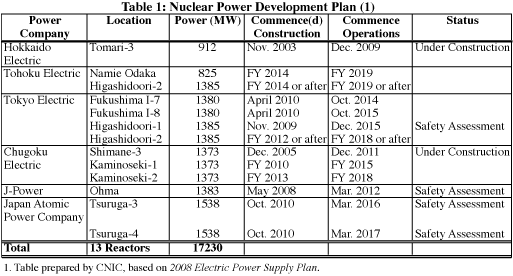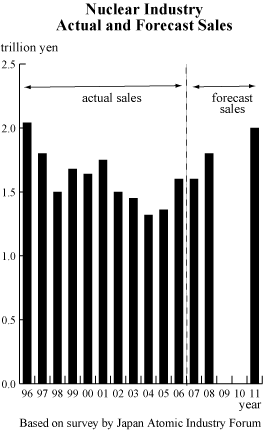Electric Power Supply Plan in an Era of Saturated Demand Nuke Info Tokyo No. 124
In April, the Ministry for Economy, Trade and Industry’s Agency for Natural Resources and Energy announced the 2008 Fiscal Year Electric Power Supply Plan Outline. The Plan brings together the plans of all the electric power companies (EPCO). Although it is called a “Plan”, as usual it has little relation to reality. A look at the plan for construction of new nuclear reactors reveals that the dates have been pushed back year after year. Some have been postponed for over 10 years.

Of course, reality is reflected in some aspects of the plan. The seven Kashiwazaki-Kariwa reactors, shut down last July as a result of the Chuetsu-oki earthquake in Niigata Prefecture, and Shika-1, which was shut down due to the cover-up of a criticality incident, are not included in the FY 2008 Plan. Both Shika-1 and Shika-2 were left out of the FY 2007 Plan. Shika-2 was shut down due to turbine damage. It recommenced operation at the end of FY 2007, but new problems immediately forced it to shut down again. However, as far as the FY 2008 Plan is concerned, it is operational again.
It is no longer possible to predict demand growth for Tokyo Electric Power Company (TEPCO) and Kansai Electric Power Company (KEPCO), which provide power to the megalopolises of Kanto and Kansai. This fact is plainly evident in the Plan.
Two years ago, in the FY 2006 Electric Power Supply Plan, TEPCO predicted that peak power output would reach 64.71 GW by 2015. However, this figure was reduced to 61.19 GW in the FY 2008 Plan, while the peak power output predicted for 2017 was only 62.36 GW, still less than the prediction for 2015 in the FY2006 Plan. Likewise, two years ago KEPCO predicted maximum power output of 31.06 GW for 2015, but in the FY 2008 plan this was reduced to 30.51 GW, while the corresponding figure for 2017 was still only 30.83 GW.
All the EPCOs registered record total electric power demand (kWh) in FY 2007. Nevertheless, despite the fact that last summer was a record-setting heat wave, neither TEPCO nor KEPCO exceeded the records set five and six years ago respectively for peak power output (kW). Because the peak power output for the two biggest EPCOs did not rise, the record set six years ago for the nine regional EPCOs from Hokkaido to Kyushu combined was not exceeded either.
Decisions to construct power stations are determined by peak power output, so as long as peak power output does not increase, EPCO’s want to postpone construction of new nuclear power plants. Relative to the predicted growth in demand (whether or not demand will in fact grow is unclear), it is obvious that the output of the planned reactors is too large. Compared to the other planned reactors, the 825 MW Namie Odaka reactor is small, but that is because the construction plan goes back 40 years. The plan has been postponed year after year ever since. Apart from Namie Odaka, all the planned reactors are large scale. It is easy to understand why EPCOs hesitate to take the plunge. The output of nuclear reactors is difficult enough to adjust at the best of times. They are either operating at full throttle, or they are not operating at all, so if the reactors are too big to start with, they are a real problem.
The upshot of all this is that, besides the two currently under construction, the plans for eight of the other eleven planned reactors were pushed back one more year. Commencement of operations at Ohma was not pushed back, but commencement of construction is 9 months behind last year’s schedule. Construction was postponed in last year’s Plan also, so the proposed time required for construction has shrunk from 5 years 8 months to 3 years 11 months. Considering that the ABWR to be constructed at Ohma will be Electric Power Development Co.’s (J-Power) first nuclear power plant and that it will be the first full-MOX plant in the world, this schedule is patently absurd. There is no doubt that eventually the commencement of operations date will be pushed back too. In the case of Tsuruga-3&4, the dates were not changed in this year’s Plan, but both were pushed back two years in the FY 2007 Plan.
The Japanese government’s response to global warming presupposes the construction of all thirteen planned reactors. It is a disgrace that it is responding to the greatest crisis in human history by tinkering with vacuous desktop plans such as this.
Nuclear Industry Developments in FY 2006
In February, the Japan Atomic Industrial Forum (JAIF) published the results of its nuclear industry survey. The results come from responses to a questionnaire by 11 EPCOs, 278 minerals and manufacturing companies and 24 trading companies.
 According to this survey, total sales of minerals and manufacturing companies are now on an upward trend after a low of 1.6 trillion yen in FY 2004. A further rise is not predicted in FY 2007 (perhaps the FY 2006 increase was too big), but sales worth 2 trillion yen are optimistically forecast for FY 2011. However, the increase in FY 2006 was from business other than nuclear power plants, such as the Rokkasho Reprocessing Plant, while nuclear reactor machinery continued its downward trend.
According to this survey, total sales of minerals and manufacturing companies are now on an upward trend after a low of 1.6 trillion yen in FY 2004. A further rise is not predicted in FY 2007 (perhaps the FY 2006 increase was too big), but sales worth 2 trillion yen are optimistically forecast for FY 2011. However, the increase in FY 2006 was from business other than nuclear power plants, such as the Rokkasho Reprocessing Plant, while nuclear reactor machinery continued its downward trend.
The downward trend in orders was reversed and at the end of FY 2006 (31 March 2007) orders were 1.8 trillion yen, 11% higher than the previous year. However, JAIF cautioned that it was not clear whether this represented a genuine upward shift. As explained in the above discussion of the Electric Power Supply Plan, EPCOs are not enthusiastic about new construction, so whether or not increased orders can be expected in future depends on the prospects of exports by the major manufacturers. Those prospects are far from clear.
Nishio Baku (CNIC Co-Director)
